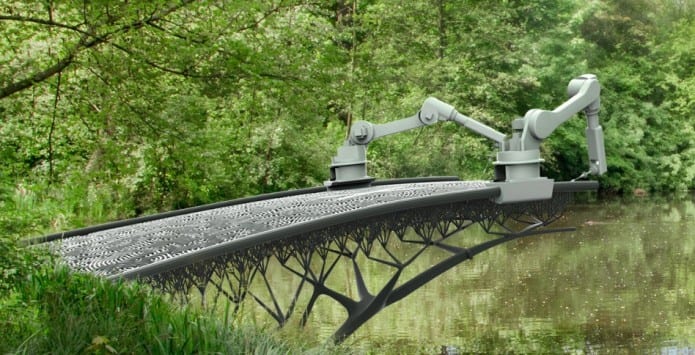World’s first 3D-Printed Steel Bridge To Span Amsterdam Canal and Will be Drawn By Robotic Arms
A Dutch startup has unveiled plans to build the world’s first 3D-printed bridge across an Amsterdam canal, a technique that could become standard on future construction sites.
The engineering startup company MX3D, which is behind this bold attempt aims to ‘print’ the complexed and ‘intricate’ structure in 3D using robots to ‘draw’ the bridge over water in the centre of Amsterdam. They hope to start the project by September.
If all goes as planned, the machines will begin printing on one side of the canal, making rail supports to slide on and exactly draw the mid-section of the bridge into being as it makes its way to the other side.
MX3D say the technology at the most important position of this project uses the ‘Printing Outside the box’ principle, basically allowing curved shapes to be ‘printed’ in mid-air.
Collaborators including software company Autodesk and construction firm Heijmans, will use what are known as 6-axis industrial robots that will heat up the metal to 1,500 degrees Celsius (around 2,700 degrees Fahrenheit) taking great care and thoroughness to wield the structure drop-by-drop, using a computer program to make the complexed design.
The bridge’s designer Joris Laarman said “The underlying principle is very simple. We have connected an advanced welding machine to an industrial robot arm.”
“We now use our own intelligent software to operate these machines so they can print very complex metal shapes which can differ each time,” he also said.
Eva James, MX3D spokeswoman said that the robotic arm until now was used only to print smaller metal structures; however, the bridge will be the first ever large-scale deployment of the technology.
She also added that it is hoped that the bridge will be a first step towards implementing the technique used on construction sites, specially those involving dangerous tasks such as on high buildings.
The technique also discards the need for a temporary structure on outside of the building, as the robot arms makes use of the very structure they print as support.
The designers are in discussion with the Amsterdam city council to finalise a site for the project that they hope to finish by mid-2017.
“I strongly believe in the future of digital manufacturing and local production,” said Laarman. “It’s a new form of craftsmanship.”
“ This bridge will show how 3D printing finally enters the world of large-scale, functional objects and sustainable materials while allowing unprecedented freedom of form,” he said.
Charlene Verweij, Amsterdam City Council Spokeswoman said the Dutch capital was supporting the project.
“We are still in negotiations as to where exactly the bridge will be built,” she said.
If successful, Amsterdam’s engineering achievement will take off the limitations of size and shape that presently restricts the applications of 3D-printing.
